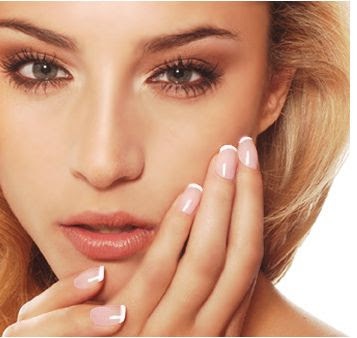 Nails are part of the body which, although small but very necessary for every human being. Nails protect the soft tissue underneath. Imagine if on every finger you have no nails. You will not be able to do the job comfortably.
Nails are part of the body which, although small but very necessary for every human being. Nails protect the soft tissue underneath. Imagine if on every finger you have no nails. You will not be able to do the job comfortably.For women the nail is of particular concern. They often colors for more beautiful nails. Even make special care of their nails. But there are other benefits that we can get just by looking at the color or condition of our nails.
Nail color can reflect the general health and lifestyles and habits of nail care. Anyone who is concerned about the discoloration of the nails If you want to see the health condition of yourself, try to observe the signs that exist on your nails. Healthy nails will be colored pink. When they appear white or yellow spots then it is a sign that your health is not good.
What Causes Yellow Nails and how to prevent
1. smoking
Perhaps the most common causes of yellow nail smoking. For years, heavy tobacco use, both finger nails and skin can become stained yellow or yellowish-brown by the nicotine and tar in cigarette smoke.
The best way to remove these stains - and gain many other health benefits - is to stop smoking. If the stop is not possible, staining may be reduced by placing a cigarette in an ashtray between puffs rather than holding it in your fingers.
2. long used nail polish
Another common cause of yellow nails are long used nail polish. Dark color is applied directly to the nail the most likely cause staining, although the constant use of nail polish anywhere can give a yellowish tinge. This problem can be solved by applying the base coat of clear nail polish under the dark, and periodically leave the nails are not painted to give them "rest".
Removing Yellow Stains
Various home remedies have been proposed to remove yellow stains from nails; These include:
- Soak your nails in fresh lemon juice
- Soak your nails in denture cleaning solution (follow manufacturer's instructions to dissolve the tablets in the water)
- Using a nail whitening pencil to hide stains
- Using a nail buffer to remove stains (excessive buffing ever, as this thin and weaken the nail.)
3. nail fungus infection
nail fungus infection is the most common of all nail disease. Nails or, more generally, the nails may be affected. Infected nails become thick, yellowish in color and crumbly. Infection usually begins at the tip and grow downward until the entire nail is affected. It is impossible to clean itself, so it is important to see a doctor for treatment.
Oral Health Problems medicines prescribed by doctors are generally more effective than topical medications, especially in advanced infection. fungal treatment Over-the-counter is also available, although their effectiveness varies. The following simple steps can help reduce the risk of fungal nail infections.
- Avoid walking barefoot in public places.
- Change socks (preferably cotton) every day.
- Do not share socks or shoes.
- Keep your feet clean and dry them thoroughly after washing, especially between the toes.
- Wear protective gloves for dish-washing and household tasks wet.
- Avoid wearing nail polish and artificial nails, which can trap moisture against the nails and encourage growth of fungi.
- Ensure that the manicure and pedicure tools are clean before use.
Yellow nail syndrome is a rare disorder in which the lymphatic system and chest problems occur together with nail thickening, yellow or yellowish-green. Nails grow slowly and in severe cases can be separated from the nail. A vitamin E ointment or food supplements can improve the appearance of nails affected.
No comments:
Post a Comment